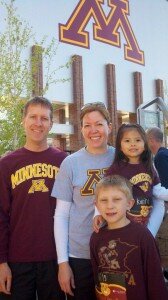Creating an Inclusive Wellness Community : Guest Author Sara Bakken Lee
 Earlier this month, as part of a graduate program at the University of Minnesota Public Health Institute, I took a class, “Communicating about Health Disparities: Are you sending the right message?” Discussion focused on systems, structures, environments, policy, resource allocation, data collection, research (stay with me here, it gets more interesting, I promise!) as they relate to the relationship between health, race, cultural differences and place/where one lives. It was a thought-provoking class, with the instructor providing several examples of case studies, ads, public health campaigns and then questioning us on the purpose of each and how they were likely received by the intended audience.
Earlier this month, as part of a graduate program at the University of Minnesota Public Health Institute, I took a class, “Communicating about Health Disparities: Are you sending the right message?” Discussion focused on systems, structures, environments, policy, resource allocation, data collection, research (stay with me here, it gets more interesting, I promise!) as they relate to the relationship between health, race, cultural differences and place/where one lives. It was a thought-provoking class, with the instructor providing several examples of case studies, ads, public health campaigns and then questioning us on the purpose of each and how they were likely received by the intended audience.
One assignment following the class was to “reflect” on an idea or strategy that captured our attention and describe how that concept affects our career in public health. Because my interests focus on all aspects of wellness and access to health care, the concept from the class that stood out most to me is how we communicate about health and wellness across cultures and frame health messages.
In Paris, where I live, and adjoining Olmsted County, where I work, we are fortunate to live among many cultures, each contributing to the richness of our community. Throughout this specific class, however, I couldn’t help but think of my own role in communication. How is wellness perceived in other cultures? Do individuals think of wellness as something individual? Or family-oriented? Appropriate for the workplace? Related only to good physical health? Perhaps even something “not for me?” As we look to communicate about wellness within our county and our state, how can we be more inclusive to promote wellness to other cultures?
Having lived in another country for several weeks, I personally experienced being in the minority and what it feels like to be confused about, well, everything. I couldn’t read the signs, I couldn’t find my favorite foods in the grocery store, when I went for a walk around the neighborhood I realized I wasn’t wearing the “right” clothes. I felt out of place and like everyone was laughing at me. It made me think about how people from other countries may feel in my home community. I returned to my own community with a better understanding and appreciation for inclusiveness.
Because of our international experience, our family decided a few years ago to host an exchange student. We had such a great experience, we hosted again and had another amazing cultural experience. In addition to bringing another culture, another perspective to our own family, we were able to share that experience with the students at Grand Meadow, so that they could better understand, “hey, the world isn’t made up of white Minnesotans!”
Sometimes our goal in communicating should be to help others think objectively, as these experiences helped me rethink messages across cultures. Instead of trying to change someone’s mind, instead, give them something to think about. Thinking about wellness communication as “us” vs. “them” creates a divide and sets up barriers to achieving our mutual goals. Without considering an individual’s environment or background, it’s easier to “blame” the individual for lack of concern for health and wellness.
Several national studies have been done that offer perspective on how social, economic and environmental conditions have a relationship to the health status of residents in particular communities. The findings suggest that communities need to address the structures and systems that create and perpetuate inequality to close racial and ethnic health gaps. In our own community, we need to understand what and where those gaps are in order to remedy them.
My personal goal is to continue these discussions. I invite comments to this blog post. What can YOU do, either as an individual or in your workplace or as part of a wellness committee do to promote inclusivity when it comes to wellness messaging? When thinking about wellness opportunities, consider these things: Is the event/activity accessible by all? Is the cost reasonable? Have you run your ideas by someone from another ethnic community? Are healthy recipes available using foods used by ethnic groups? Are they available in multiple languages? I know I personally need to consider these things.
Mower Refreshed is exciting. Not only is the group growing to include more people of ethnic backgrounds, but it’s an inclusive group that considers the structures and systems that may often be barriers to good health for all.
As Mower Refreshed continues its work, our goal should be to continue to work with those in our community to ensure that every citizen of Paris, regardless of their race, ethnicity, where they live, can enjoy the opportunity to live a healthy and productive life.
Sara Bakken Lee works at Mayo Clinic in Employee and Community Health and on Healthy Living projects. She is pursuing a Master’s Degree in Public Affairs with a public health concentration at the University of Minnesota and is involved in wellness efforts at her kids’ school in Grand Meadow. She lives with her family in rural Dexter.




